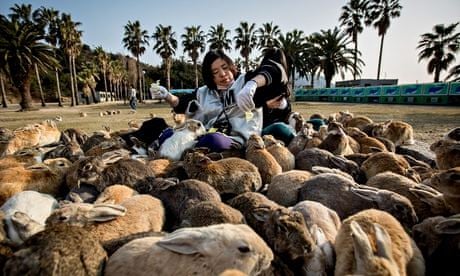As islands that are occupied by wild animals go, Okunoshima, better known as Usaga Jima or Rabbit Island, is probably the cutest.
Situated in the East Sea/Inland Sea of Japan, the small island is occupied by hundreds of wild rabbits that roam the forests and paths, chase tourists, appear in viral videos and just generally lounge around. They also provide a much needed counterbalance to the island's otherwise dark history – as the production site for Japan's chemical weapons during the second world war.
Of course, Japan being the birthplace of kawaii – the distinct cultural appreciation of all things cute – the bounding herds of friendly rabbits are a much bigger attraction than the Poison Gas Museum. But although the source of the rabbits remains a mystery, it may be that the origins of the island's fluffy residents is intertwined with its history as manufacturer of chemical weapons.
Between 1929-1945, the Japanese army secretly produced over 6,000 tons of poison gas on Okunoshima, which was removed from maps of the area and chosen because of its discreet location and distance from civilian populations. At the time, an unfortunate colony of rabbits was brought to the island in order to test the effects of the poison.
While some claim the rabbits that live there now are relatives of the test bunnies that were freed by the workers at the end of the war, others are less convinced; it has been reported that all the rabbits were killed when the factory ceased production. The other theory is that eight rabbits were brought to the island by schoolchildren in 1971, where they bred (presumably like rabbits) until they reached their current population, which is potentially in the thousands. And with the island being a predator-free zone – dogs and cats are banned – if the number of rabbits hasn't hit the thousands yet, it's inevitable it will do soon.
Now the island, a short ferry ride from the mainland, is a popular tourist resort with a small golf course, camping grounds and beautiful beaches. Tours are also given of the now derelict poison gas facilities, while ruins of military outposts are dotted around the island.
In some ways the allure of the bunnies is similar to that of Japan's and, more recently, England's cat cafes. Most apartments in Japan forbid pets, so an opportunity to enjoy the company of a furry friend is a welcome one.
Visitors to Okunoshima can buy food for the remarkably tame rabbits, who became an online hit this February when this video of a woman being chased by a "stampede" of rabbits was posted online.
Pig Island, The Bahamas
Firstly; yes, pigs can swim. Secondly; there's a place in the Bahamas where you can swim with them. As if the tropical island didn't have enough going for it, there's a beach on the uninhabited Big Major Cay where you can paddle among these swimming swine. Rumour has it that the pigs were dropped on the island by a group of sailors who planned to return and eat them, but luckily for the pigs they never did and the animals have survived to this day. Another, more cynical, version of the story is that the pigs were put there deliberately as a tourist attraction – but who cares about that when you're swimming with pigs!
Assateague, Virginia, US
The rural island of Assateague, on the Virginia coast, is home to a herd of around 300 feral horses, believed by some to have made their way to the island after surviving a shipwreck, although there are no records to confirm this. Another theory is that settlers brought them here in the 17th century to get round a tax that farmers were required to pay for keeping livestock on the mainland. Still, the tax-free horses – made famous by Marguerite Henry's children's book Misty of Chincoteague – are a popular sight among visitors who drop by the island to see the wildlife and tour the waterways by kayak.
Monkey Island, Puerto Rico
To many, Monkey Island is among the greatest computer games of the 90s. But for those who know about Cayo Santiago, off the coast of Puerto Rico, Monkey Island is a far more literal proposition. The island, which is only 600 metres long by 400 wide, has a population of almost 1,000 Rhesus monkeys, and is used as a research area for students and academics doing field studies into the primates. The original population was first established on the island in 1938, and is renowned as one of the leading research sites of its kind in the world.

Comments (…)
Sign in or create your Guardian account to join the discussion